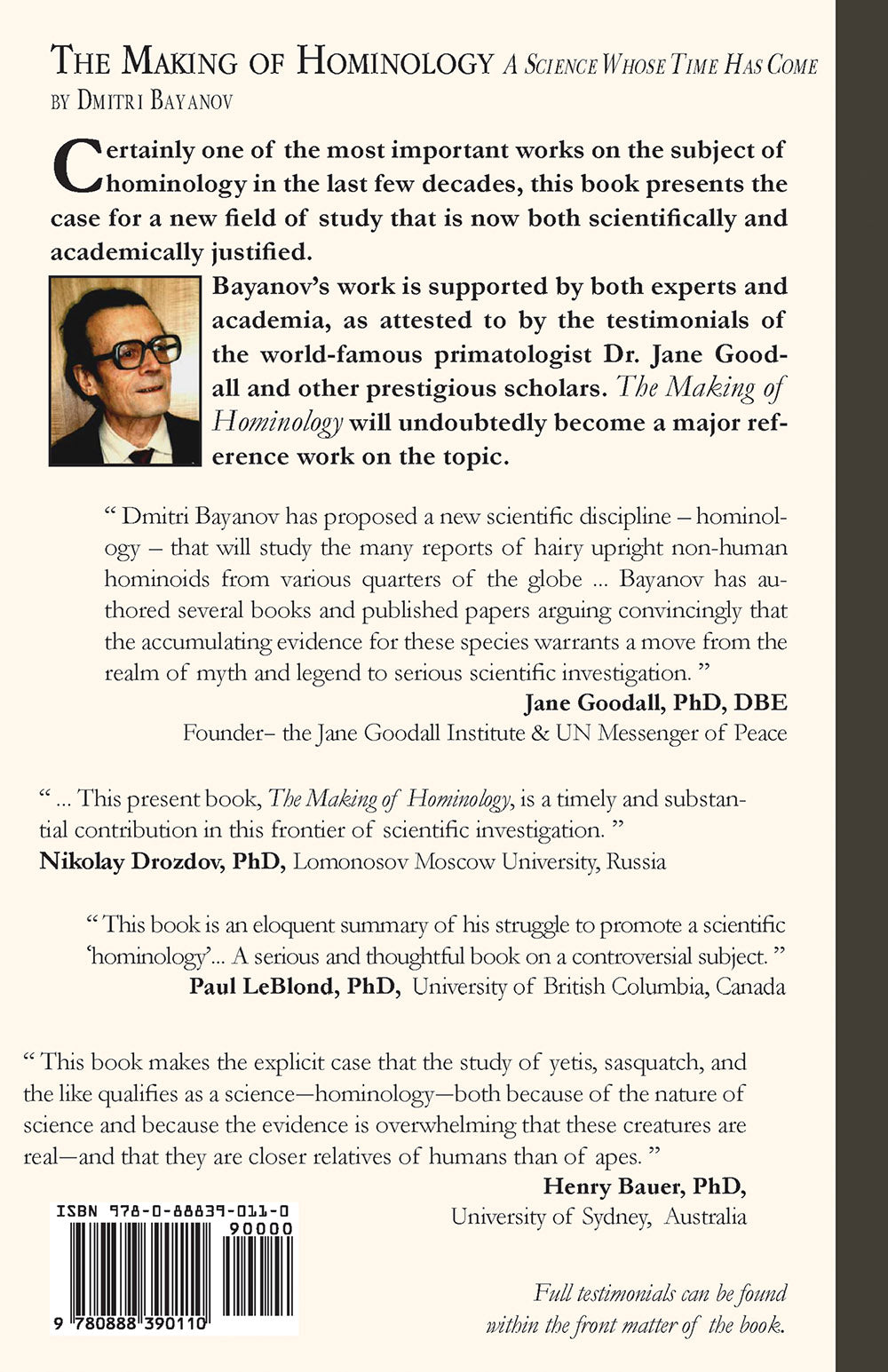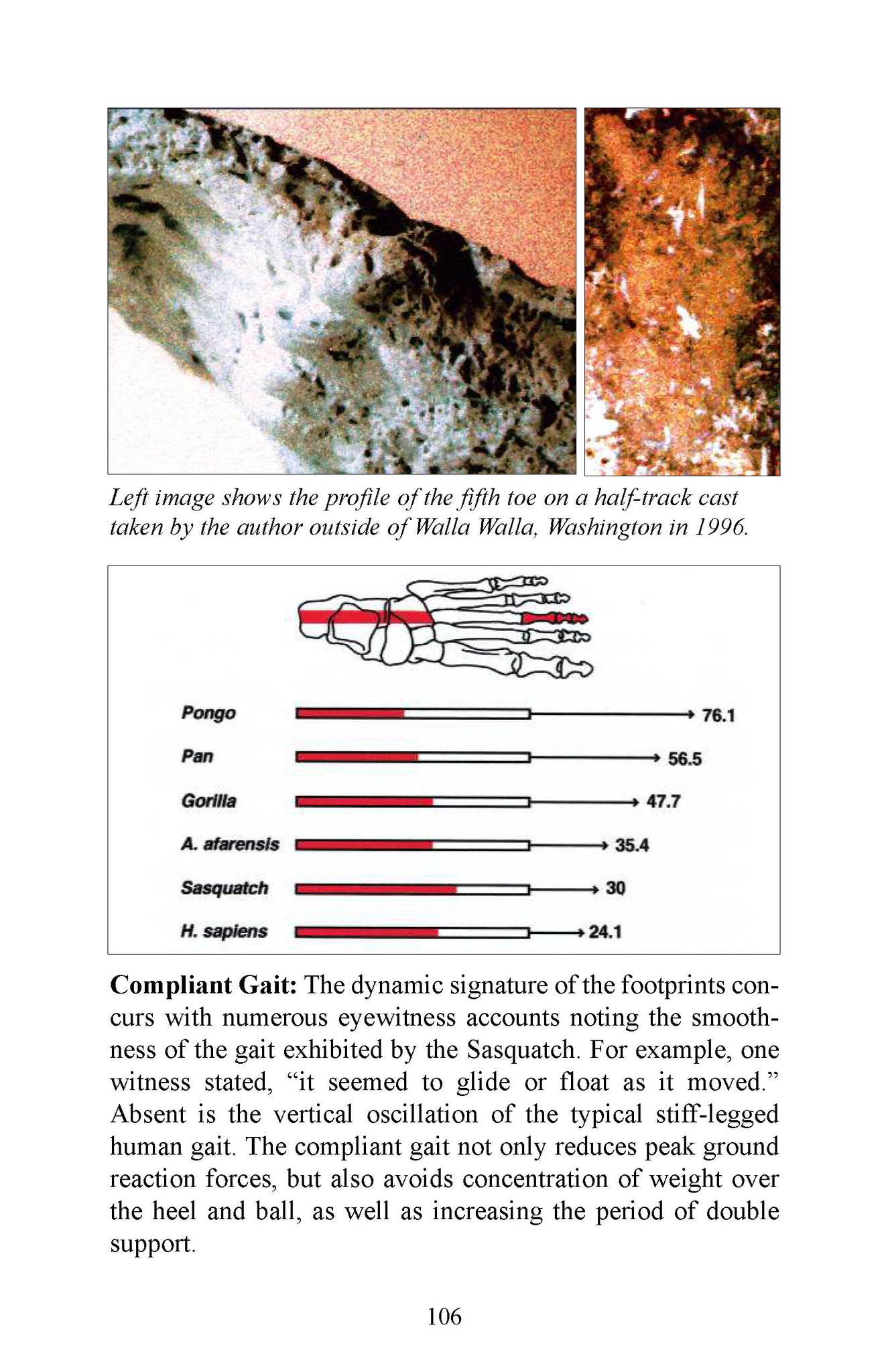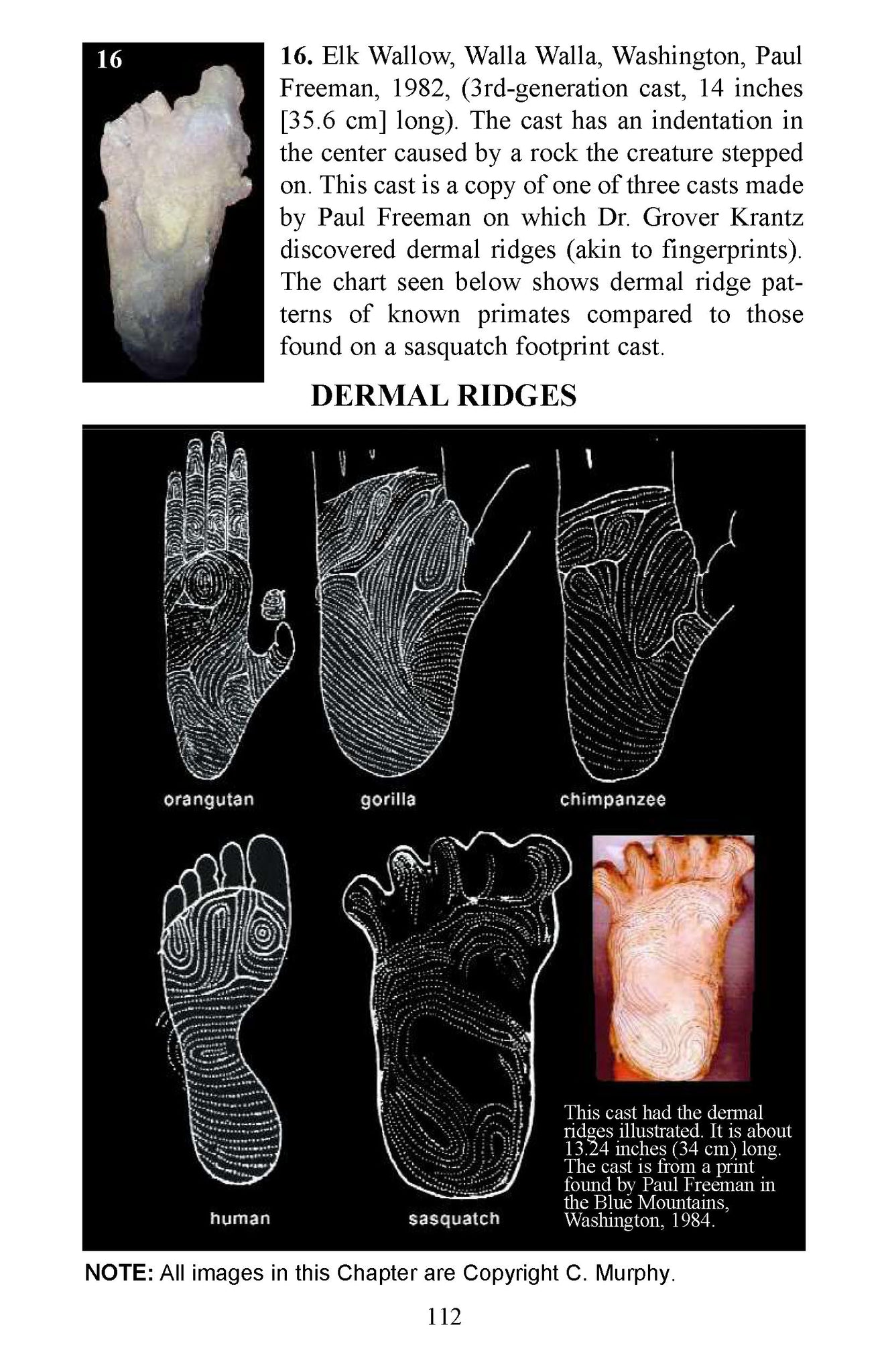




The Making of Hominology: a science whose time has come
Details
By: Dmitri Bayanov in association with Christopher Murphy
ISBN: 978-0-88839-011-0 [trade paperback]
ISBN: 978-0-88839-285-5 [trade hardback]
ISBN: 978-0-88839-289-3 [epub format]
Binding: Trade Paper / Trade Cloth
Size: 8.5" X 5.5"
Pages: 152
Photos: 42
Illustrations: 0
Publication Date: 2019
Description
The Making of Hominology is a detailed work aimed at moving the study of relict hominoids from the fringes of science to a fully recognized scientific discipline—The Science of Hominology. The main author, Dmitri Bayanov (born 1932), worked directly with Professor Boris Porshnev and other early Russian scientists investigating the possible existence of Relict Hominoids. Bayanov’s long journey began in the early 1960s and has continued until this day. This book covers the subject from the dawn of written communications in Europe and Asia, and then in North America. Dmitri Bayanov coined the term “Hominology” and from the outset has sought to convince the general scientific community that there is enough evidence to support his recommendation. His “arguments” reflect his significant understanding of the subject and depth of his studies. What he presents is truly convincing. From a scientific standpoint, this book is the most important work on Hominology ever written. It is both fascinating and highly educational with a special illustrated section on what we know about North America’s hominoid—the sasquatch or bigfoot.
Author Biography
Dmitri Bayanov was born in Moscow, Russia, in 1932 He went on to become one of the foremost Russian cryptozoologists and hominologists alive today, Dmitri originally graduated from a teachers’ college in 1955 with a major in humanities. After studying under such individuals as Professor B.F. Porshnev and P.P. Smolin, chief curator of the Darwin Museum in Moscow, Dmitri took part in Marie-Jeanne Koffmann’s expedition in search of the Russian snowman (almasty) in the Caucasus and made reconnaissance trips in the same region on his own. Dmitri is currently an active member of the Relict Hominoid Research Seminar at the Darwin Museum (since 1964) and became its chairman in 1975. He was a founding board member of the International Society of Cryptozoology and served on its Board of Directors until 1992. He is also credited with coining the terms “hominology” and “hominologist” in the early 1970s to describe the specific study of unknown hominoids and those who study them. Dmitri’s hominological career has been spent mainly on the study of relict populations of hominoids including the Russian snowman and the North American Sasquatch or Bigfoot. This is reflected in his several books published in Russia and Canada. He currently lives in Moscow, Russia.
Christopher L. Murphy retired in 1994 after 36 years of service with the British Columbia Telephone Company (now Telus). During his career, he authored four books on business processes. After retirement, he taught a night school course on vendor quality management at the B.C. Institute of Technology. An avid philatelist, Chris has written several books on Masonic Philately. Chris got involved in the sasquatch mystery when he met Rene Dahinden, who lived nearby, in 1993. He then worked with Rene in producing posters from the Patterson/Gimlin film and marketing sasquatch footprint casts. In 1996, Chris republished Roger Patterson's 1966 book, Do Abominable Snowmen of America Really Exist?, and Fred Beck's book, I Fought the Apemen of Mt. St. Helens. In 1997, Chris published Bigfoot in Ohio: Encounters with the Grassman, a book he authored in association with Joedy Cook and George Clappison of Ohio. In 2000, Chris embarked on a project to assemble a comprehensive pictorial presentation on the sasquatch. This initiative led to his 2004 sasquatch exhibit at the Vancouver (BC) Museum and the publication of Meet the Sasquatch, the first edition of this book. In due course, Chris wrote a supplemental section to Roger Patterson's book, which was republished in 2005 by Hancock House Publishers under the title, The Bigfoot Film Controversy. The following year, Chris updated his Ohio book, again with his two previous associates, and it was published in 2006 by Hancock House under the title, Bigfoot Encounters in Ohio: Quest for the Grassman. Chris's sasquatch exhibit next traveled to the Museum of Mysteries in Seattle, where it was displayed for five months in 2005. In June of the following year, it opened at the Museum of Natural History in Pocatello Idaho, where it was shown for 15 months. Chris has also attended and presented at many sasquatch symposiums, and has taken part in several television documentaries on the subject.
Book Endorsements
"Dmitri Bayanov has proposed a new scientific discipline—hominology—that will study the many reports of hairy upright non-human hominoid like creatures from various quarters of the globe. Beginning in the 1960s, Bayanov worked directly with Professor Boris Porshnev and other Russian scientists investigating reports of relict hominoids, such as the almasty, described as a possibly extant Neanderthal. Continuing that work, Bayanov has authored several books and published papers arguing convincingly that the accumulating evidence for these species warrants a move from the realm of myth and cryptozoology to serious scientific investigation. A lifetime of scholarly examination of this question, with evidence spanning from the dawn of written communications to the present, has culminated in this important book – The Making of Hominology".
-- Jane Goodall, Ph.D., DBE;
Founder - the Jane Goodall Institute,
UN Messenger of Peace
"For years Dmitri Bayanov has argued forcefully for a scientific approach to the interpretation of the evidence for wild hominids (Sasquatch, Yeti, Almasty…). This book is an eloquent summary of his struggle to promote a scientific “hominology”. It also provides examples of the sober and detailed examinations which he advocates, applied to some of the available evidence. A serious and thoughtful book on a controversial subject".
-- Paul LeBlond, Ph.D., Professor Emeritus,
Dept. Physics and Oceanography
University of British Columbia
"Serious study of the “snowman” phenomenon began with Prof. Boris Porshnev's groundbreaking book The Present State of the Question of Relict Hominoids (1963). He noted in it the emerging science of still unclassified higher bipedal primates that later developed into a discipline termed hominology. As a Moscow University student, I attended Prof. Porshnev’s eyeopening lectures on this subject and was presented by him a copy of his famous book. The relevant research had been initiated by him at the Academy of Sciences and continued at the Darwin Museum by a group of enthusiasts, headed first by museum Chief Curator Pyotr Smolin and followed by Dmitri Bayanov. His present book The Making of Hominology, written in association with Christopher Murphy, is a timely and substantial contribution in this frontier of scientific investigation ".
-- Nikolay Drozdov, Ph.D., Doctor of Sciences in Biology;
Doctor in Geography – Chair of Biogeography,
Lomonosov Moscow University, Russia,
"This book makes the explicit case that the study of yetis, Sasquatch, and the like qualifies as a science—hominology—both because of the nature of science and because the evidence is overwhelming that these creatures are real —and that they are closer relatives of humans than of apes. The author has been with this project essentially from the beginning, and his accounts of its history are authentic. A valuable resource for both fans and skeptics".
-- Henry Bauer, Ph.D.
Professor Emeritus of Chemistry and Science Studies
University of Sydney, Australia
Foreword by Jeff Meldrum
In The Making of Hominology, senior Russian homin investigator Dmitri Bayanov offers a timely retrospective and introspective consideration of the conception, gestation, difficult labor and imminent birth of a new scientific discipline. In science, names and definitions of terminology are integral to effective communication of knowledge. “Hominology” is the study of “homins,” a generic term coined by Bayanov to include all forms of “hairy bipedal primates, whose degree of kinship with humans (Homo sapiens) is still to be established.” It is a name essentially synonymous with “relict hominoids,” a term first popularized by Boris Porshnev, and carried on, after much deliberation, in the title of The Relict Hominoid Inquiry (www.isu.edu/rhi), a singular academic journal established in 2012, as an attendant to the birth of this revolutionary discipline.
The account of this travail contains numerous dichotomies, highlighting contrasting perspectives, interpretations, politics and paradigms. There have been and continue to be interesting distinctions in the US vs. Soviet institutional approaches to this scientific enigma. There have been and continue to be polarized opinions about the nature of homins— more human-like vs. more ape-like. There have been and continue to be disparities in opinion regarding the uniformity vs. diversity of homins – e.g., Sanderson’s Neo-Giants (sasquatch or bigfoot) vs. Neanderthaloids (almas). Exploring these differences makes for intellectual “dramatic tension” that can breathe vigor into the nascent discipline, desirably, and lend resolution and delineation. To this end, The Making of Hominology offers a seminal contribution to the conversation.
With the spirit of the Bolsheviks, but hardly speaking in the majority, Bayanov parallels Kuhn’s principles of scientific revolution with the struggles for scientific recognition of hominology, in the midst of a generational paradigm shift. This paradigm shift has turned from the single-species hypothesis, which posited that two culture-bearing hominins could not exist at the same time, an assumption of the competitive exclusion principle. Now, however, the fossil record shows that myriad now-extinct hominins existed simultaneously across the same landscapes. There was not a single-file line of evolution, but a bushy tree, making room for the possibility that Bigfoot and other relict hominoids could exist. The question remains, what evidence points to the probability of such species existing today? Bayanov offers a frank indictment of the scientific communities on both continents, as ones “duped by the mass media,” rendered largely ignorant of the primary data, in spite of Sisyphean efforts by some to present the evidence through scholarly channels, and engage objective discussion. “The theory is the tool that allows you to see the facts,” anthropologist Esteban Sarmiento says. “For people to see something totally new, they’d need a theory that would allow for it. Unless the academics have new theories, some facts will always be closed to them.” Bayanov credits Porshnev as among the first to provide a theory to accommodate the “anomalous” facts.
Against this backdrop, Bayanov considers the nature of some of the most compelling anomalous evidence at present—the footprints and the film. Smithsonian primatologist John Napier, one of the few scientists to offer a relatively objective assessment of the evidence, concluded on the basis of the footprints, that sasquatch does exist. “There must be something in north-west America that needs explaining, and that something leaves man-like footprints.” (Napier, 1973, p. 205). Bayanov reprints a poster presentation I delivered at the annual meetings of the American Association of Physical Anthropologists in 1999. This evaluation commenced in 1996 when I personally examined a fresh track line in the ground, comprised of 15-inch hominoid footprints. More than 20 years later, I have assembled over 300 specimens of footprints attributed to various relict hominoids around the world. Examples of these are presented in Chris Murphy’s contributed chapter.
It is timely, on the heels of its 50th anniversary, to consider the most compelling photographic evidence—the Patterson and Gimlin film, taken in 1967. Russian investigators made significant contributions to the study and analysis of this film. Here again, another dichotomy is revealing—the contrasting opinions, after regarding the very same film clip, arrived at by the academicians vs. those of the non-academic professionals, who, it is noted, had no “axe to grind.”
The history of the alternate perceptions and pronouncements about the film is very revealing of the sometimes glacial-pace of the realization of paradigm shifts in science. To illustrate, consider once again Dr. Napier, who was among the first scientists to critically examine the film in the USA. In his book, he ultimately came to the conclusion that the film was a hoax, although he acknowledged he couldn’t put his finger on exactly what to base that conclusion upon. Subsequently, he offered this caveat, “The upper half of the body bears some resemblance to an ape and the lower half is typically human. It is almost impossible to conceive that such structural hybrids could exist in nature. One half of the animal must be artificial.” (Napier, 1973, p. 91). In essence, the film subject did not fit commonly held preconceptions of what a hominid should look like, not to mention that the prevailing paradigm would not even allow for the existence of another extant bipedal hominid. Shortly after the publication of his book, a more complete fossilized skeleton a specimen of Australopithecus afarensis, among our earliest hominin ancestors (popularly dubbed “Lucy”) was discovered in East Africa, and publically announced to much fanfare. The experts were cited in the press as noting how interesting a specimen it was—from the waist up it looks much like a chimpanzee, while from the waist down it resembled a human. It seems such hybrids of structure were no longer inconceivable after all. Perhaps the potential of other bipedal homins existing alongside Homo sapiens should not be assumed as inconceivable either.
Kuhn has suggested that it may take the passing of a generation before a novel paradigm can take root and flourish. Bayanov, in essence, is issuing a call to action, which if realized, will likely first be responded to by the upcoming generation of scholars. I have seen signs of such germinations and suspect The Making of Hominology may contribute to their nurturing.
Jeff Meldrum, PhD
Professor of Anatomy & Anthropology
Idaho State University
Book Reviews
The proponents of hairy hominoids share many frustrations when it comes to science not recognizing the existence of these beings, and there would have to be a paradigm shift in one of these scientists before they will acknowledge even the possibility of what are admittedly right now cryptozoological creatures to exist. In this reviewer's opinion, only a body will satisfy science fully.
But that is beside the point. This book may be Bayanov's swan song and final message to science, but it will be long-lasting and will perhaps influence a budding science student to look into this subject and say, "Maybe there is something to this." But let us hope the Russian researchers continue to look into this and also to inspire future generations. This is a great and fascinating book, one which I give a perfect 10.
-- Henry May, July 2019
This book finally classifies an important creature plus describes and names the discipline of its study. The Mission is completed by the authors step by step in this urgently needed, yet highly organized and well-written book. A strange ape-Human like Hominid that has been reported and described for centuries by natives and endless credible eyewitnesses has defied being studied by U.S. scientists. Hopefully through the birth of Hominology described in this book, all discrimination toward the subject will start to change.
-- Doug Hajicek, August 2019
Dmitri Bayanov’s book, “The Making of Hominology – A Science whose time Has Come”, is a fascinating read for any student of biology or anthropology who values the importance of evidence, even if it challenges historical or even prevailing thought. His book traces the birth and history of the scientific discipline of hominology, the multi-disciplinary study of physical evidence that overwhelmingly tells us that our species is not the only living survivor of that bushy tree we call hominid evolution.
Bayanov documents the challenges of those who questioned the traditional academic judgment that there could be no surviving bipedal homins (sometimes called relic hominids), to be investigated in the forests or mountains of our world, and those who may ask, “why not?...” Increasingly, anthopology textbooks have commented on the possibility of surviving relic hominoids. Bayanov’s work brilliantly confirms the observations of dozens of published scholars world-wide that the serious scientific study of such homins whether sasquatches, yetis, Bigfoot or orang-pendeks, is not only a valid one but commendable and recommended. The accolades this work has received by a newer scientific generation support the author’s contention that the published documentation and research on the subject has added a new chapter in science, one that finally deserves its own name, “hominology”.
Bayanov traces the historical scientific evolution of hominolgy from the time of Linnaeus, noting how dismissal of oral traditions or folk-beliefs by then-prevalent academic minds limited wider awareness of a growing body of evidence, even including tracks or possible physical remains. Bayanov also confirms, as did wildlife biologist John Bindernagel, that there is a historical pattern to accepting any previously unrecognized species, that of complete dismissal, admitting the possibility of existence, acknowledging a probability of same and possibly final recognition. Bayanov makes a supportable case that we are at a time when serious study has accumulated sufficient evidence to at least allow the possibility of the continued existence of homins in remote places worldwide. It is clear that the accumulating evidence has survived the first stage of its evolution as a serious discipline, that of outright dismissal by all. That further serious studies in what may be called the discipline of hominology are being called for by credentialed scholars is a credit to science and will certainly open a myriad of possibilities for future students interested in hominology studies. This book is a highly recommended read for anyone interested in the new frontiers of science.
-- J. Robert Alley, BA, PT, DC, August 2019
Media
King5 News Coverage
Lacey Museum Interview with Chris Murphy
King5 Lacey Museum Coverage
Script and Definitions of Hominology